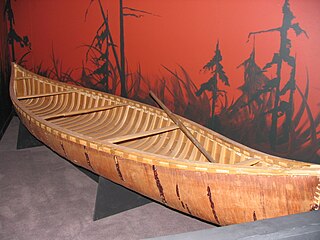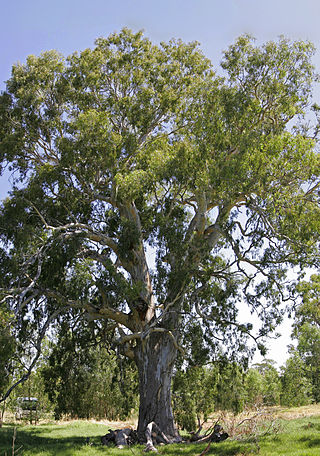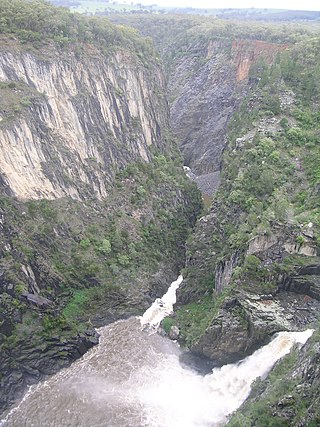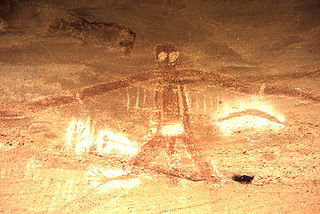
The didgeridoo is a wind instrument, played with vibrating lips to produce a continuous drone while using a special breathing technique called circular breathing. The didgeridoo was developed by Aboriginal peoples of northern Australia at least 1,000 years ago, and is now in use around the world, though still most strongly associated with Indigenous Australian music. In the Yolŋu languages of the indigenous people of northeast Arnhem Land the name for the instrument is the yiḏaki, or more recently by some, mandapul. In the Bininj Kunwok language of West Arnhem Land it is known as mako.

The Murray River is a river in Southeastern Australia. It is Australia's longest river at 2,508 km (1,558 mi) extent. Its tributaries include five of the next six longest rivers of Australia. Together with that of the Murray, the catchments of these rivers form the Murray–Darling basin, which covers about one-seventh the area of Australia. It is widely considered Australia's most important irrigated region.
The Wiradjuri people are a group of Aboriginal Australian people from central New South Wales, united by common descent through kinship and shared traditions. They survived as skilled hunter-fisher-gatherers, in family groups or clans, and many still use knowledge of hunting and gathering techniques as part of their customary life.

A canoe is a lightweight narrow water vessel, typically pointed at both ends and open on top, propelled by one or more seated or kneeling paddlers facing the direction of travel and using paddles.

Eucalyptus camaldulensis, commonly known as the river red gum, is a species of flowering plant in the family Myrtaceae, and is endemic to Australia. It is a tree with smooth white or cream-coloured bark, lance-shaped or curved adult leaves, flower buds in groups of seven or nine, white flowers and hemispherical fruit with the valves extending beyond the rim. A familiar and iconic tree, it is seen along many watercourses across inland Australia, providing shade in the extreme temperatures of central Australia.

The Fitzroy Gardens are 26 hectares located on the southeastern edge of the Melbourne central business district in East Melbourne, Victoria, Australia. The gardens are bounded by Clarendon Street, Albert Street, Lansdowne Street, and Wellington Parade with the Treasury Gardens across Lansdowne street to the west.

The Riverland is a region of South Australia. It covers an area of 9,386 square kilometres (3,624 sq mi) along the River Murray from where it flows into South Australia from New South Wales and Victoria downstream to Blanchetown. The major town centres are Renmark, Berri, Loxton, Waikerie, Barmera and Monash, and many minor townships. The population is approximately 35,000 people.

Australian Aboriginal artefacts include a variety of cultural artefacts used by Aboriginal Australians. Most Aboriginal artefacts were multi-purpose and could be used for a variety of different occupations. Spears, clubs, boomerangs and shields were used generally as weapons for hunting and in warfare. Watercraft technology artefacts in the form of dugout and bark canoes were used for transport and for fishing. Stone artefacts include cutting tools and grinding stones to hunt and make food. Coolamons and carriers such as dillybags, allowed Aboriginal peoples to carry water, food and cradle babies. Message sticks were used for communication, and ornamental artefacts for decorative and ceremonial purposes. Aboriginal children’s toys were used to both entertain and educate.

The Kororoit Creek is a watercourse of the Port Phillip catchment, rising in the outer north western suburbs of Melbourne, in the Australian state of Victoria.

A woomera is an Australian Aboriginal wooden spear-throwing device. Similar to an atlatl, it serves as an extension of the human arm, enabling a spear to travel at a greater speed and force than possible with only the arm.

Coolamon is an anglicised version of the Wiradjuric word guliman used to describe an Australian Aboriginal carrying vessel.

Brachychiton populneus, commonly known as the kurrajong, is a small to medium-sized tree found naturally in Australia in a diversity of habitats from wetter coastal districts to semi-arid interiors of Victoria, New South Wales and Queensland. Carrejun and carrejan were the indigenous names of trees in the foothills of the Blue Mountains near Sydney, and the bark was used for twine and fishing lines. The extended trunk is a water storage device for survival in a warm dry climate. The bell-shaped flowers are variable in colour while the leaves vary considerably in shape. The leaves are either simple and pointed, or may be 3–9 lobed. Saplings grow from a drought and fire resistant tap-rooted tuber.

The Apsley Falls are two waterfalls on the Apsley River in the Northern Tablelands region of New South Wales, Australia. The falls are located about 20 kilometres (12 mi) east of Walcha, and 1 kilometre off the Oxley Highway in a deep gorge, that is part of the Oxley Wild Rivers National Park. They are the first falls in a succession of dramatic drops in an area that has some of the most remarkable scenery in Eastern Australia. The first drop of the falls is about 65 metres (213 ft) in depth, and the second, which is about 800 metres (2,625 ft) further on, plummets 58 metres (190 ft) to the bottom of the gorge.
Aboriginal dugout canoes were a significant advancement in canoe technology. Dugout canoes may have been stronger, faster, and more efficient than previous types of bark canoes. The Australian Aboriginal peoples' use of these canoes brought about many changes to both their hunting practices and society.

Aboriginal sites of New South Wales consist of a large number of places in the Australian state of New South Wales where it is still possible to see visible signs of the activities and culture of the Australian Aboriginals who previously occupied these areas.

The Paakantyi language, also spelt Paakantji, Barkindji, Barkandji, and Baagandji, and is also known as the Darling language, is a nearly extinct Australian Aboriginal language spoken along the Darling River in New South Wales from the present-day Queensland Border to Bourke, then all along the river down to Wentworth. It includes much of the back country around the Paroo River, plus an area along the Coopers Creek into Queensland and also through the Broken Hill district. Check the map of Australia to the right below, which indicates out territory. The people's, and language name, refers to the Paaka with the suffix -ntyi meaning "belonging to". See below. The speakers of the language are known as the Paakantyi. The variant is slightly different along the river proper and ceases at the confluence of the Darling-Barka and the Murray rivers. We did cross the Murray by bark canoes to meet the river people back early last century.

Aboriginal sites of Victoria form an important record of human occupation for probably more than 40,000 years. They may be identified from archaeological remains, historical and ethnographic information or continuing oral traditions and encompass places where rituals and ceremonies were performed, occupation sites where people ate, slept and carried out their day to day chores, and ephemeral evidence of people passing through the landscape, such as a discarded axe head or isolated artefact.
Boat building has been a part of the history of Ontario, Canada for thousands of years. From the hand-crafted birch bark canoes of the indigenous people to modern factory-built speedboats, the construction of small boats for fishing, transportation and later water sports has been a widespread commercial activity in the province.

The Yuwibara, also written Yuibera and Juipera and also known as Yuwi, after their language, are an Aboriginal Australian people, originating from the area around present-day Mackay, on the east coast of Queensland, Australia.
The Girramay are an Australian Aboriginal tribe of northern Queensland.



























